
Albert Ferenc Kovács with his wife Miriam
We are extremely lucky to have some of the heroes of the 1956 Hungarian anti-communist uprising are still with us, willing and able to share their historic experience with coming generations. In the following article we will present two of them: one recognized and honored with an award, while another living a quiet life across the Ocean, whose name and story was almost lost for posterity.
Edina Koszmovszky, one of the better known heroines of 1956, lives in France. She was the “girl in the red coat” who, at the age of 18, read the 14-point demand of the university youth from the balcony of the Radio in Budapest, thus fanning the flames of revolution.
She was promised that the students’ demands would be broadcast on the radio, but the promise was never fulfilled. The crowd lined up outside the radio to protest, but armed members of the communist state security, the dreaded AVO, fired on the protester. Young Hungarian army conscripts, who were also ordered to disperse the crowd, have instead joined the demonstrator, thus beginning the siege of the radio.
Ms. Koszmovszky and 9 others were taken hostage on the same day until they were blindfolded and led out of the building through a hole in the basement under the cover of night. She was subsequently placed under surveillance by state security, but later managed to escape to the West before they could put her on trial.
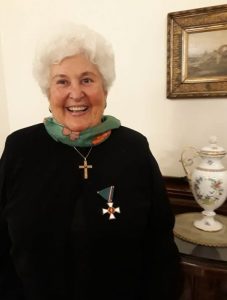
Edina Koszmovszky during the award ceremony in Paris
During a gathering on 13 October in Paris, she received the Cross of the Order of Merit of Hungary from Hungarian Ambassador George Habsburg. In the ceremonial hall of the Hungarian Embassy in Paris, the Chief of Protocol, Farhan Mona, presented her life story to the assembled celebrants, family members, friends, acquaintances and representatives of Hungarian associations in France. His Excellency Ambassador György Habsburg smiled as he handed over the prestigious award to Ms. Koszmovszky.
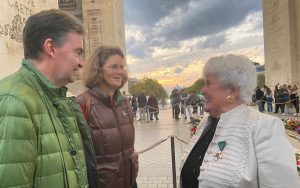
Edina Koszmovszky (R) with Ambassador Habsburg (L)
Dr. György Reményi, President of The Association of Hungarians in France (FRAMOSZ), also praised the courage of the Girl in the Red Coat recalling his personal memories of the events in Budapest’s Heroes’ Square on 24 October and 4 November 1956.
This ceremony was followed two days later by the traditional wreath-laying ceremony of the Mindszenty memorial plaque in the chapel of the Catholic Mission in Paris, where Father Márk Vlajk (Diocese of Győr) celebrated the Holy Mass. This year, Ms. Koszmovszky was also able to pay her respects at the eternal flame under the Arch of Triumph and at the tomb of the unknown soldier. At this location every year Hungarians march with about 20 Hungarian flags. Unfortunately, this year the supervisors allowed only one. The flag with the hole, symbol for the 1956 uprising, was labelled as damaged and banned from the event, as were all but one of the other regular flags, saying that they did not meet the required standards. This has never happened before in France.
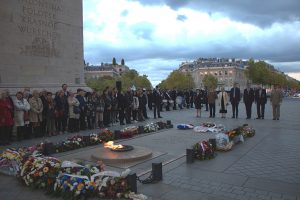
Photo: Facebook Hungarian Embassy, France
The story of another Hungarian hero of 1956, whose life and courage should be celebrated, is not so well known to the public. Albert Ferenc Kovács, lives in British Columbia as a Canadian citizen. His son, Philip has kindly sent us an email detailing his story, with photos and documents attached.
Mr. Kovács comes from the small town of Nagykőrös, south of the capital Budapest. Probably very few of the locals are aware of his deeds in 1956, although the town has recently unveiled a plaque to Mr. Kovács’s cousing, Margit Barta, one of the young martyrs of the anti-Soviet revolution.
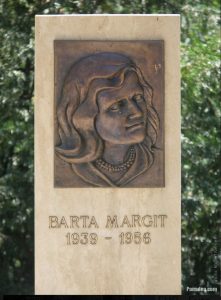
During the 1956 October uprising, Mr. Kovács volunteered as a guard with the famous Rákóczi Broadcast, a secret resistance radio station operated during the historic events. They broadcasted to the world asking for help in 5 or 6 different languages. The equipment they used was a mobile R40 type radio transmitter. Albert Kovács was a guard on the vehicle that would travel around to set up equipment, broadcast, and then dismount so they could not be found by the Russians. He served his country alongside with another guard named Tibor Tóth.
After the Soviet troops gained control of the country, he feared for his life and was forced to escape on foot. He eventually ended up in Canada, arriving with no possessions of his own. Because of the circumstances of his escape, he had no photos or other documents to prove his story, except for a newspaper article in the 1956 Manchaster Evening News, where he is shown in the company with other revolutionaries.
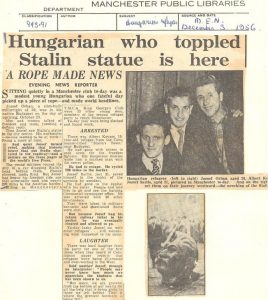
Newspaper clipping depicting Albert Kovács (C) in the Manchester Evening Standard
Mr. Kovács is now 85 years old, strong and healthy and as his son Philip remarked, “his mind is as sharp as whip”.
Featured Photo: Courtesy of Philip Kovács